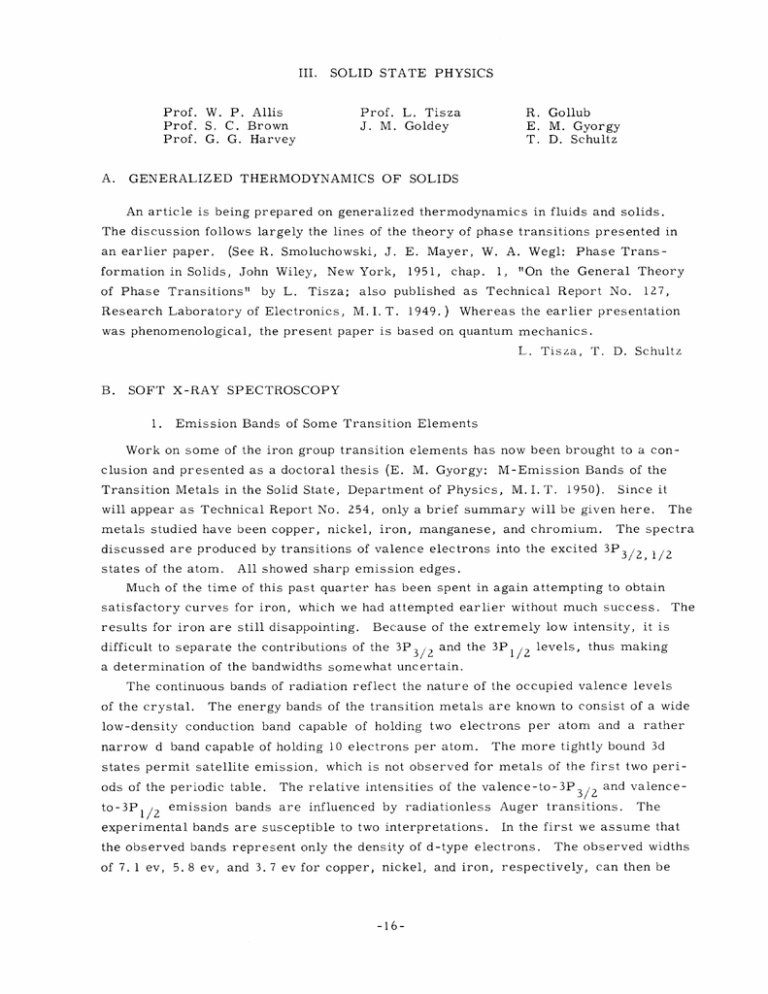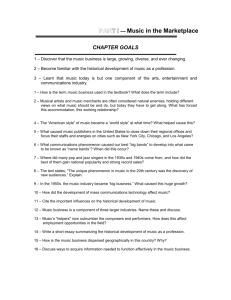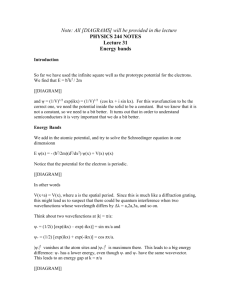III. SOLID STATE PHYSICS Prof. L. Tisza
advertisement

III. SOLID STATE PHYSICS Prof. W. P. Allis Prof. S. C. Brown Prof. G. G. Harvey A. GENERALIZED Prof. L. Tisza J. M. Goldey R. Gollub E. M. Gyorgy T. D. Schultz THERMODYNAMICS OF SOLIDS An article is being prepared on generalized thermodynamics in fluids and solids. The discussion follows largely the lines of the theory of phase transitions presented in an earlier paper. (See R. Smoluchowski, J. formation in Solids, John Wiley, of Phase Transitions" by L. New York, Tisza; Research Laboratory of Electronics, E. Mayer, W. A. Wegl: 1951, chap. 1, Phase Trans- "On the General Theory also published as Technical Report No. M. I. T. 127, 1949. ) Whereas the earlier presentation was phenomenological, the present paper is based on quantum mechanics. L. B. Tisza, T. D. Schultz SOFT X-RAY SPECTROSCOPY 1. Emission Bands of Some Transition Elements Work on some of the iron group transition elements has now been brought to a conclusion and presented as a doctoral thesis (E. M. Gyorgy: Transition Metals in the Solid State, M-Emission Bands of the Department of Physics, M. I. T. 1950). Since it will appear as Technical Report No. 254, only a brief summary will be given here. metals studied have been copper, nickel, iron, manganese, and chromium. The The spectra discussed are produced by transitions of valence electrons into the excited 3P3/ states of the atom. All showed sharp emission edges. 2 , 1/2 Much of the time of this past quarter has been spent in again attempting to obtain satisfactory curves for iron, which we had attempted earlier without much success. results for iron are still disappointing. The Because of the extremely low intensity, it is difficult to separate the contributions of the 3P3/2 and the 3P1/2 levels, thus making a determination of the bandwidths somewhat uncertain. The continuous bands of radiation reflect the nature of the occupied valence levels of the crystal. The energy bands of the transition metals are known to consist of a wide low-density conduction band capable of holding two electrons per atom and a rather narrow d band capable of holding 10 electrons per atom. The more tightly bound 3d states permit satellite emission, which is not observed for metals of the first two periods of the periodic table. to-3P 1 /2 The relative intensities of the valence-to-3P3/Z and valence- emission bands are influenced by radiationless Auger transitions. experimental bands are susceptible to two interpretations. The In the first we assume that the observed bands represent only the density of d-type electrons. The observed widths of 7. 1 ev, 5. 8 ev, and 3. 7 ev for copper, nickel, and iron, respectively, can then be -16- (III. compared with the calculated widths of the d bands. The calculated widths of the copper and iron d bands are 5. 5 ev and 5. 0 ev, respectively. for the width of the d band in nickel: SOLID STATE PHYSICS) Two calculations have been made the cellular method gives 4. 9 ev, while a Bloch perturbation calculation gives 2. 5 ev. In the second interpretation we assume essentially that an appreciable part of the experimental bands is due to the conduction electrons. This interpretation permits a plausible explanation of a number of the observed features of the bands. With the second viewpoint, the widths of the observed bands can be compared with the widths of the conduction bands calculated, using the free-electron approximation. These values are 7. 1 ev, 5. 3 ev, and 2. 3 ev, for copper, nickel, and iron, respectively. The numbers of free electrons used in these calculations are obtained from magnetic data. The other experimental bandwidths are 5. 8 ev for manganese and 7. 2 ev for chromium. Theoretical values are not available for these metals. G. G. Harvey, E. M. Gyorgy 2. Electron Multiplier Studies Some experimental work has been done on a six-stage beryllium-copper electron multiplier of the Allen type in order to obtain information on the yield as a function of the length of time of exposure to air and of the voltage drop per stage. Electrons, accelerated through a potential difference corresponding to that per stage, were injected into the multiplier. Current measurements were made at the input and output of the multiplier, from which values of the multiplication per stage were obtained. The com- paratively high current levels used caused decreases of the yield with time, which partially masked the effect being measured, though the results are not without significance. It was hoped that it might be possible, as a result of these measurements, to curtail the necessary treatment of the plates after exposure to air, a tedious and timeconsuming process, but it is apparent that this cannot be done without sacrifice of yield. G. G. Harvey, E. M. Gyorgy, R. Gollub C. MICROWAVE STUDY OF SEMICONDUCTORS The measurement of the dielectric coefficient of germanium in the 10-cm region by the resonant cavity method yielded a value that was higher by approximately 1.5 than values of 16 to 16. 5 obtained at other frequencies. In order to ascertain whether there is truly a frequency dependence of the dielectric coefficient or simply an unknown error in the cavity method, another measurement is being made at the same frequency using a waveguide transmission method. J. M. Goldey -17-



